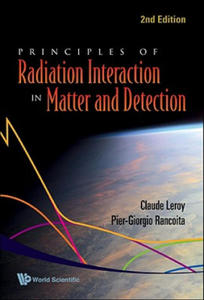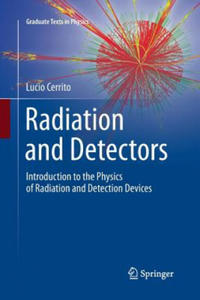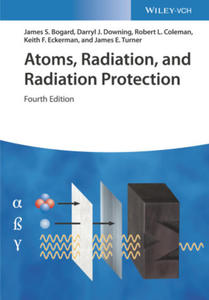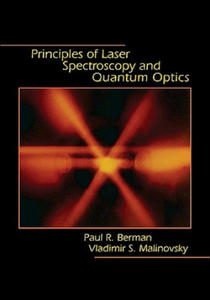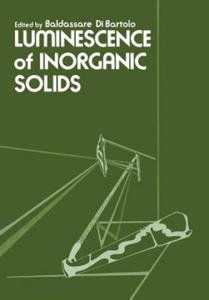gigant principles of radiation interaction in matter and detection mhjioifcqcrqcfmhomhp
- znaleziono 7 produktów w 3 sklepach
Principles Of Radiation Interaction In Matter And Detection (2nd Edition) World Scientific Publishing Co Pte Ltd
Książki / Literatura obcojęzyczna
This book, like its first edition, addresses the fundamental principles of interaction between radiation and matter and the principle of particle detectors in a wide scope of fields, from low to high energy, including space physics and the medical environment. It provides abundant information about the processes of electromagnetic and hadronic energy deposition in matter, detecting systems, and performance and optimization of detectors. In this second edition, new sections dedicated to the following topics are included: space and high-energy physics radiation environment, non-ionizing energy loss (NIEL), displacement damage in silicon devices and detectors, single event effects, detection of slow and fast neutrons with silicon detectors, solar cells, pixel detectors, and additional material for dark matter detectors.This book will benefit graduate students and final-year undergraduates as a reference and supplement for courses in particle, astroparticle, and space physics and instrumentation. A part of it is directed toward courses in medical physics.The book can also be used by researchers in experimental particle physics at low, medium, and high energy who are dealing with instrumentation.
Sklep: Libristo.pl
Principles Of Radiation Interaction In Matter And Detection (2nd Edition)
Książki Obcojęzyczne>Nieprzypisane
0x007783d700000000
Sklep: Gigant.pl
Radiation and Detectors Springer International Publishing AG
Książki / Literatura obcojęzyczna
This textbook provides an introduction to radiation, the principles of interaction between radiation and matter, and the exploitation of those principles in the design of modern radiation detectors. Both radiation and detectors are given equal attention and their interplay is carefully laid out with few assumptions made about the prior knowledge of the student.Part I is dedicated to radiation, broadly interpreted in terms of energy and type, starting with an overview of particles and forces, an extended review of common natural and man-made sources of radiation, and an introduction to particle accelerators. Particular attention is paid to real life examples, which place the types of radiation and their energy in context. Dosimetry is presented from a modern, user-led point of view, and relativistic kinematics is introduced to give the basic knowledge needed to handle the more formal aspects of radiation dynamics and interaction. The explanation of the physics principles of interaction between radiation and matter is given significant space to allow a deeper understanding of the various technologies based on those principles. Following an introduction to the ionisation mechanism, detectors are introduced in Part II, grouped according to the physical principle that underpins their functionality, with chapters covering gaseous detectors, semiconductor detectors, the scintillation process and light detectors. The final two chapters describe the phenomenology of showers and the design of calorimeters, and cover additional phenomena including Cherenkov and transition radiation and the detection of neutrinos. An appendix offers the reader a useful review of statistics and probability distributions.The mathematical formalism is kept to a minimum throughout and simple derivations are presented to guide the reasoning and facilitate understanding of the working principles. The book is unique in its wide scope and introductory level, and is suitable for undergraduate and graduate students in physics and engineering. The reader will acquire an awareness of how radiation and its exploitation are becoming increasingly relevant in the modern world, with over 140 experimental figures, detector schematics and photographs helping to relate the material to a broader research context.
Sklep: Libristo.pl
Atoms, Radiation, and Radiation Protection 4e Wiley-VCH Verlag GmbH
Książki / Literatura obcojęzyczna
This fourth edition of the classic textbook has been updated and revised by a renowned team of experienced health physicists and book authors, to include current physiokinetic and dosimetric models as recommended by the International Commission on Radiological Protection. In addition, all units are now given using the SI system, making the book even more useful to an international audience, while the sections on statistics have been completely rewritten to make them more accessible.As a result, the text offers advanced students and professionals comprehensive coverage of the major concepts behind the origins and transport of ionizing radiation in matter. It covers the detection and measurement of radiation and the statistical interpretation of the data, thoroughly describing the procedures that are used to protect humans and the environment from the potential harmful effects. Throughout, the basic principles are elucidated using numerous worked examples that exemplify practical applications and each chapter includes problem sets (with partial answers) and extensive tables and graphs for continued use as a reference work.
Sklep: Libristo.pl
Principles of Laser Spectroscopy and Quantum Optics Princeton University Press
Książki / Literatura obcojęzyczna
"Principles of Laser Spectroscopy and Quantum Optics" is an essential textbook for graduate students studying the interaction of optical fields with atoms. It also serves as an ideal reference text for researchers working in the fields of laser spectroscopy and quantum optics. The book provides a rigorous introduction to the prototypical problems of radiation fields interacting with two- and three- level atomic systems. It examines the interaction of radiation with both atomic vapors and condensed matter systems, the density matrix and the Bloch vector, and applications involving linear absorption and saturation spectroscopy. Other topics include hole burning, dark states, slow light and coherent transient spectroscopy, as well as atom optics and atom interferometry. In the second half of the text, the authors consider applications in which the radiation field is quantized. Topics include spontaneous decay, optical pumping, sub-Doppler laser cooling, the Heisenberg equations of motion for atomic and field operators, and light scattering by atoms in both weak and strong external fields. The concluding chapter offers methods for creating entangled and spin-squeezed states of matter.Instructors can create a one-semester course based on this book by combining the introductory chapters with a selection of the more advanced material. A solutions manual is available to teachers. It offers rigorous introduction to the interaction of optical fields with atoms. Applications include linear and nonlinear spectroscopy, dark states, and slow light. It includes extensive chapter on atom optics and atom interferometry. Conclusion explores entangled and spin-squeezed states of matter Solutions manual (available only to teachers).
Sklep: Libristo.pl
Selected problems in physics with examples and exercises Politechnika Gdańska
FIZYKA
What is physics? The answer to this question has been changing, because physics also changes with time. But physics has always dealt with the basic rules governing the world: the macro-world as well as the world of atoms, electrons and nucleons. Physicists are concerned with various kinds of matter and radiation and their interactions. Their main purpose is to find, understand and use the basic laws that govern the natural world. The foundation of physics is experiment. Experimental observation of the phenomena of nature allows physicists to find the rules and principles that relate these phenomena. This leads to formulation of models and theories, which form our perceptions of the investigated phenomena. Any physical model or theory must always be confronted with experiment. Essential contradictions between a particular model or theory and experimental data are a signal that the model or theory should be corrected or replaced by a new one. This confrontation is a source of development of physics and its continuous approaching a truth of nature. Contemporary physics is a highly developed basic science with many fields, which are the foundation of all engineering and technology. Especially strong relations exist between physics and chemistry. Ever since chemistry ceased to be a purely phenomenological science, chemists not only employ certain laws of physics, but even include some complex and subtle physical phenomena and physics' arcane methods of measurement in their own research. This results in a gradual obliteration of the border line between some branches of chemistry and physics. Spis treści: 1. INTRODUCTION 1.1. The nature of physics 1.2. The language and units. of physics 1.3. How to study physics? Questions and problems 2. FUNDAMENTAL LAWS AND LAWS OF CONSERVATION IN PHYSICS 2.1. The meaning of fundamental laws 2.2. On the laws of conservation in physics 2.2.1. Newton's laws of motion 2.2.2. Conservation of momentum 2.2.3. Conservation of angular momentum 2.3. Work and energy 2.3.1. Definition of work in physics 2.3.2. Energy 2.3.3. The law of conservation of energy 2..3.3.1. Conservation of mechanical energy 2.3.3.2. Conservation of total energy Questions and problems 3. KINETIC THEORY AND LAWS OF THERMODYNAMICS 3.1. The microscopic interpretation of temperature 3.2. Measuring temperature 3.3. Internal energy and equipartition of energy 3.4. Laws of thermodynamics 3.4.1. The first law of thermodynamics 3.4.2. The second law of thermodynamics Questions and problems 4. ELECTROMAGNETIC INTERACTIONS 4.1. Static electric force 4.1.1. Electric charges 4.1.2. Quantization and conservation of charge 4.1.3. Electrical interaction between two charged particles - Coulomb's law 4.1.4. Electrical interactions in a system of several charges 4.2. Electric field 4.2.1. Graphic representation of electric fields 4.3. Gauss's law 4.3.1. Flux of electric field 4.3.2. Gauss's law 4.4. Electric potential and voltage 4.4.1. Electric potential energy 4.4.2. Electric potential 4.5. Capacitance and electric energy storage 4.5.1. Capacitors and capacitance 4.5.2. Energy storage 4.6. Electric current and magnetic force 4.6.1. Electric current 4.6.2. Ohm's law 4.6.3. Magnetic force and magnetic field 4.6.4. Magnetic field of linear current. Ampere's law 4.6.5. Gauss's law for magnetic field 4.7. Electromagnetic induction 4.7.1. Faraday's law of induction 4.7.2. Self-induced emf (? s ) 4.8. Maxwell's equations Questions and problems 5. SELECTED PROBLEMS OF MODERN PHYSICS 5.1. The photoelectric effect 5.1.1. Photoelectrons 5.1.2. Fundamental features of the photoelectric effect 5.1.3. Einstein's theory of the photoelectric effect 5.2. Photons and electrons 5.2.1. X-ray photons 5.2.2. The Compton effect 5.3. The Bohr model of the atom of hydrogen 5.3. 1. Bohr's assumptions and postulates 5.3.2. Quantization of electron's total energy5.3.3. Electron jumps 5.3.4. Advantages and limitations of the Bohr model 5.4. Wave-particle duality 5.4.1. De Broglie's hypothesis 5.4.2. Experimental verification of de Broglie's hypothesis Questions and problems 6. NUCLEAR PHYSICS 6.1. Nuclear size and structure 6.1.1. Constituents of the nucleus 6.1.2. Nuclear size 6.1.3. Nuclear forces 6.2. Radioactivity 6.2.1. Kinetics of radioactive decay 6.2.2. Beta decay 6.2.3. Alpha decay 6.2.4. Gamma decay 6.3. Nuclear reactions 6.3.1. General remarks 6.3.2. The fission reaction 6.3.3. Nuclear fusion Questions and problems EXERCISES APPENDIX A. Mathematics A.1. Vector algebra A.2. Derivatives A.3. Integrals APPENDIX B. ENGLISH-POLISH PHYSICS DICTIONARY.
Sklep: Księgarnia Techniczna
Luminescence of Inorganic Solids Springer-Verlag New York Inc.
Książki / Literatura obcojęzyczna
These proceedings report the lectures and seminars of a course entitled "Luminescence of Inorganic Solids," held at Erice, Italy, June 15-30, 1977. This course '7aS an activity of the International School of Atomic and No1ecu1ar Spectroscopy of the "Ettore Hajorana" Centre for Scientific Culture. The course opened with an overvievl of the present status of luminescence research and with an assessment of its future trends. The following lectures introduced the basic formalism behind the interaction of matter with the radiation field and the lattice phonons. The luminescence properties of various classes of in organic materials were treated next, for the specific cases of unfilled-shell activators (transition metal, lanthanide and actinide ions) and filled-s~e11 activators (s2 and d10 ions). Different models suitable for the description of the luminescence properties of semiconductors vlere examined next. The dynamics of energy transfer and relaxation in the excited state of t;1e activators were treated in lectures devoted to the luminescence phenomena of sensitization, concentration quenching and thermal quenching. Finally, the relevance of luminescence studies to the field of phosphor technology and to the laser field Has examined. Each lecturer began the treatment of this topic(s) at a fundamental level and finally reached the current level of research. The sequence of the lectures was determined by the requirements of a didactical presentation. The emphasis of the course was primarily on basic principles. The formal lectures Here complemented by seminars and discussions.
Sklep: Libristo.pl
Sklepy zlokalizowane w miastach: Warszawa, Kraków, Łódź, Wrocław, Poznań, Gdańsk, Szczecin, Bydgoszcz, Lublin, Katowice
Szukaj w sklepach lub całym serwisie
1. Sklepy z gigant pl principles of radiation interaction in matter and detection mhjioifcqcrqcfmhomhp
2. Szukaj na wszystkich stronach serwisu
t1=0.037, t2=0, t3=0, t4=0.022, t=0.038

